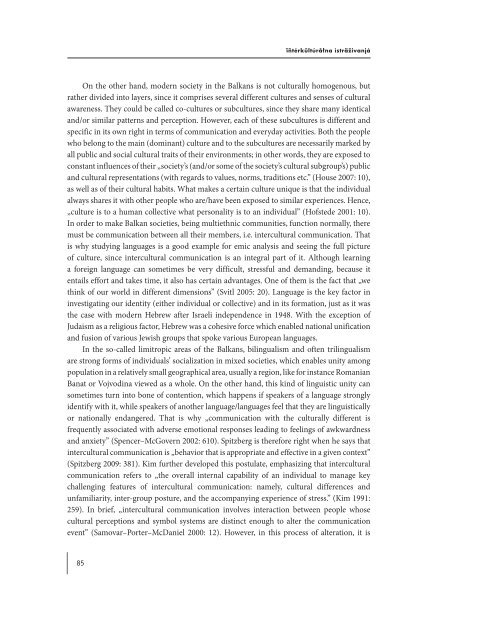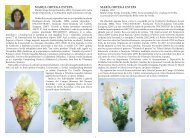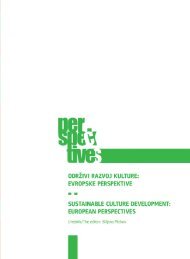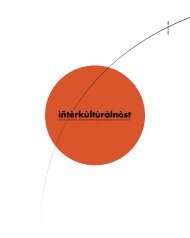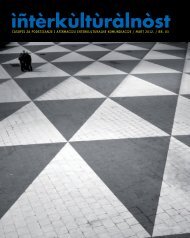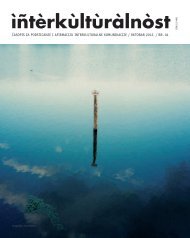Preuzmite kompletan Äasopis broj 2 u PDF formatu - Portal kulture ...
Preuzmite kompletan Äasopis broj 2 u PDF formatu - Portal kulture ...
Preuzmite kompletan Äasopis broj 2 u PDF formatu - Portal kulture ...
You also want an ePaper? Increase the reach of your titles
YUMPU automatically turns print PDFs into web optimized ePapers that Google loves.
ïñtérkûltúråłna ìsträživanjá<br />
On the other hand, modern society in the Balkans is not culturally homogenous, but<br />
rather divided into layers, since it comprises several different cultures and senses of cultural<br />
awareness. They could be called co-cultures or subcultures, since they share many identical<br />
and/or similar patterns and perception. However, each of these subcultures is different and<br />
specific in its own right in terms of communication and everyday activities. Both the people<br />
who belong to the main (dominant) culture and to the subcultures are necessarily marked by<br />
all public and social cultural traits of their environments; in other words, they are exposed to<br />
constant influences of their „society’s (and/or some of the society’s cultural subgroup’s) public<br />
and cultural representations (with regards to values, norms, traditions etc.” (House 2007: 10),<br />
as well as of their cultural habits. What makes a certain culture unique is that the individual<br />
always shares it with other people who are/have been exposed to similar experiences. Hence,<br />
„culture is to a human collective what personality is to an individual” (Hofstede 2001: 10).<br />
In order to make Balkan societies, being multiethnic communities, function normally, there<br />
must be communication between all their members, i.e. intercultural communication. That<br />
is why studying languages is a good example for emic analysis and seeing the full picture<br />
of culture, since intercultural communication is an integral part of it. Although learning<br />
a foreign language can sometimes be very difficult, stressful and demanding, because it<br />
entails effort and takes time, it also has certain advantages. One of them is the fact that „we<br />
think of our world in different dimensions” (Svitl 2005: 20). Language is the key factor in<br />
investigating our identity (either individual or collective) and in its formation, just as it was<br />
the case with modern Hebrew after Israeli independence in 1948. With the exception of<br />
Judaism as a religious factor, Hebrew was a cohesive force which enabled national unification<br />
and fusion of various Jewish groups that spoke various European languages.<br />
In the so-called limitropic areas of the Balkans, bilingualism and often trilingualism<br />
are strong forms of individuals’ socialization in mixed societies, which enables unity among<br />
population in a relatively small geographical area, usually a region, like for instance Romanian<br />
Banat or Vojvodina viewed as a whole. On the other hand, this kind of linguistic unity can<br />
sometimes turn into bone of contention, which happens if speakers of a language strongly<br />
identify with it, while speakers of another language/languages feel that they are linguistically<br />
or nationally endangered. That is why „communication with the culturally different is<br />
frequently associated with adverse emotional responses leading to feelings of awkwardness<br />
and anxiety” (Spencer–McGovern 2002: 610). Spitzberg is therefore right when he says that<br />
intercultural communication is „behavior that is appropriate and effective in a given context”<br />
(Spitzberg 2009: 381). Kim further developed this postulate, emphasizing that intercultural<br />
communication refers to „the overall internal capability of an individual to manage key<br />
challenging features of intercultural communication: namely, cultural differences and<br />
unfamiliarity, inter-group posture, and the accompanying experience of stress.” (Kim 1991:<br />
259). In brief, „intercultural communication involves interaction between people whose<br />
cultural perceptions and symbol systems are distinct enough to alter the communication<br />
event” (Samovar–Porter–McDaniel 2000: 12). However, in this process of alteration, it is<br />
85


